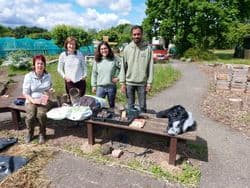What is the environmental cost of the digital world?
Digital technology is transforming arts and culture, making things more accessible to wider audiences, allowing for amazing visual displays and connecting us in ways that wouldn’t otherwise be possible. It has made collaborating with team members across the UK for this project easy. Perhaps even reducing our impact as we haven’t all had to travel around the country too much for meetings. But what is the cost of this digital age and how has PoliNations tried to mitigate our impact in this area?
There’s an invisible impact in our daily digital lives – our phones and laptops use a lot of power not just in keeping them charged but powering the servers and transferring information across the world. Apps stored on our phones use memory and space which in turns uses more energy, and incredible websites that move fast with beautiful graphics use unbelievable amounts of energy. The life cycle carbon footprint of the Information Computer Technology (ICT) sector accounts for 1.4% of global greenhouse gas emissions and 4% of global electricity use1. This is a phenomenal amount and when you start to think about all the people in the world using phones, computers and other digital systems, it starts to make sense. Put another way, if ICT were a country, it would be the 3rd highest consumer of electricity after the USA and China. And that is the situation now. Scientists predict that in the worst case scenario, electricity used by communications technology could contribute up to 23% of global greenhouse emissions by 2030. That’s 8 years away.
Enough doom and gloom. What can we do about it? Well, if the whole ICT sector switched to renewable energy, the carbon footprint could be reduced by 80%. That’s huge. And for PoliNations we have tried to minimise our digital carbon footprint too. Peter and Paul have designed our website and app to be low carbon impact. One thing that uses loads of energy is fast loading imagery so you’ll see that our website loads slowly and uses simple imagery to not use up to much energy. It also uses a system which allows the website to use substantially less power than a website built using open-sourced scripting language. In the traditional approach using PHP, each time a user interacts with the website, the site has to connect to the database, fetch the data and send it back. In our approach when content is changed, deleted, or added in the content management system, the content is retrieved by the server and saved as a complete version of the website. This means the server only needs to retrieve content when the content is updated rather than each time someone visits the site, therefore lowering the footprint per user.
The website has also been designed in phases to be efficient and avoid energy intensive rebuilds. It’s hosted on Digital Ocean which uses 100% renewable energy to power their servers in the UK. The website won’t around forever – a lhuge amount of energy is taken up by websites that are no longer in use but still loitering around on the internet. Closing the website down after the event will save unnecessary carbon emissions.
Without building a more carbon intensive version of the website, it’s hard to make a like for like comparison and know how much carbon we’re actually saving.
What can I do to reduce my digital footprint?
- A great thing to do is use refurbished laptops and phones. New devices are energy intensive to make and are reliant on the often unethical mining of raw materials.
- Think about the design and energy source for any website you run or ask your work whether they’ve considered switching to a renewably powered website.
- Move data to the cloud – 72-93% carbon savings can be made in comparison to conventional computing according to Microsoft.
- Delete all the apps, email subscriptions and online services you don’t use or need as they take up previous data and energy.
Thanks to Julie’s Bicycle’s Digital Guide for the statistics!
For more info see:
1Malmodin & Lunden, 2018, The Energy and Carbon Footprint of the Global ICT and E&M Sectors 2010–2015. Sustainability. vol. 10, no. 9. https://www.mdpi.com/2071-1050/10/9/3027







